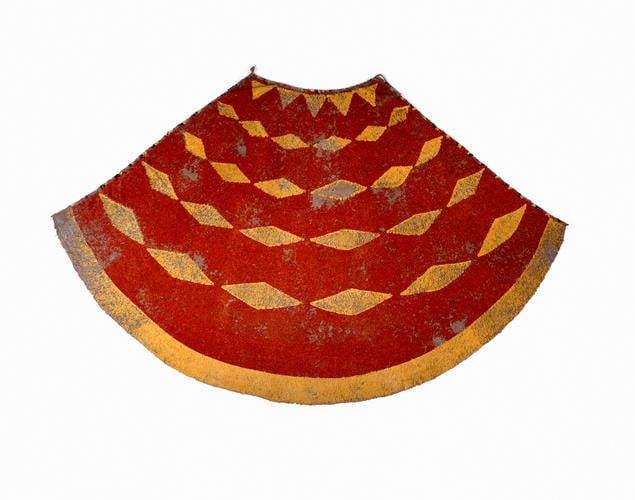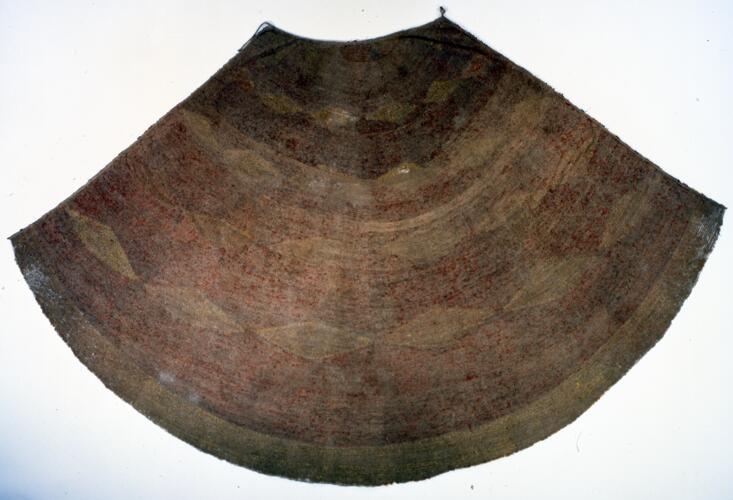-
1 of 253523 objects
Cloak ('ahu'ula) c.1800-1810
Feathers on bark cloth | 199.0 x 324.0 cm (whole object) | RCIN 69996
-
Feather cloak, semi-circular, with red, yellow and black feathers on a bark cloth ground in a geometric pattern of diamonds.
This feather cloak was sent to England in 1810 by King Kamehameha I of the Sandwich Islands. It accompanied a letter, addressed to George III, requesting British protection 'if any of the powers which you are at War with molest me', as well as 'brass Guns to defend the Islands'. A moderniser and unifier, for much of his reign Kamehameha sought British support for his attempts to expand across the Hawaiian archipelago, as well as appealing for protection against other foreign powers operating in the area. In 1794, he endeavoured to formalise this relationship when the English navigator Captain George Vancouver wintered on the island during his mapping of the Pacific Coast of North America. The letter and gift of 1810 reinforced this understanding, taking advantage of the arrival of the ship Duke of Portland. On its arrival in Britain in April 1812, the cloak was presented to the Prince Regent on behalf of the King. On 7 June it was sent to Carlton House where it was deposited in the Armoury with the Prince's vast collection of chiefly and military costume. In return, the Prince Regent sent Kamehameha a gold-laced cocked hat, uniform and tools. The Foreign Secretary, the Earl of Liverpool, wrote, 'His Majesty Commands Me to assure you that He shall feel at all times most desirous to promote the Welfare of the Sandwich Islands, and that He will give positive Orders to the Commanders of His Ships to treat with proper respect, all Trading Vessels belonging to You, or to Your Subjects.'
Feather cloaks of this kind, called 'ahu'ula, were among the most important symbols of chiefly status in Hawaii. They were worn only by the highest-ranking chiefs on ceremonial occasions or during battle. Thousands of feathers were required to make a single cloak and the scarcity of vibrant yellow feathers in particular made the garments even more precious. Yellow feathers came from the 'ö'ö (Moho nobilis) and mamo (Drepanis pacifica) birds, which are mostly black and shed only a few yellow feathers in the moulting season. Considerable manpower was required to catch the birds and remove their yellow feathers, after which they would be released back into the wild. Contrasting red feathers served as a further symbol of chiefly greatness, the colour red being closely associated with divinity throughout Polynesia.Provenance
Sent to George III by King Kamehameha I of the Sandwich Islands on 3 March 1810 and presented to the Prince Regent by General Turner on 7 June 1812. Displayed in the Armoury at Carlton House, where it was recorded as a 'Curious Feather Coat...Sent...by Tamahamaha [sic] King of the Sandwich Islands'. Displayed in the 'Museum' (now the China Museum) at Windsor Castle in 1900.
-
Creator(s)
(nationality)Acquirer(s)
-
Medium and techniques
Feathers on bark cloth
Measurements
199.0 x 324.0 cm (whole object)
Category
Place of Production
Hawaii [USA]

